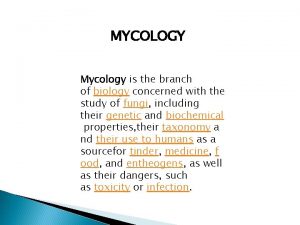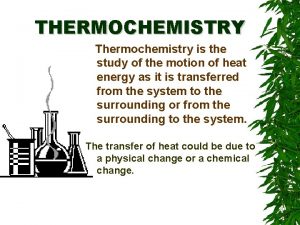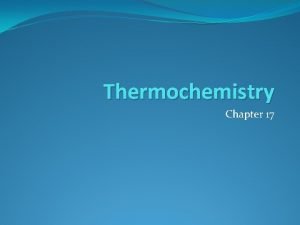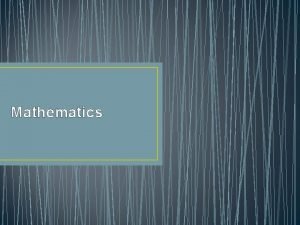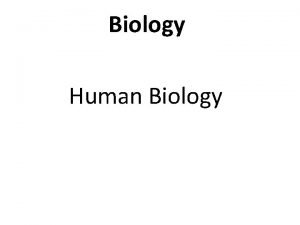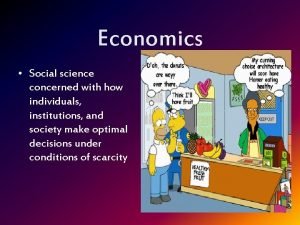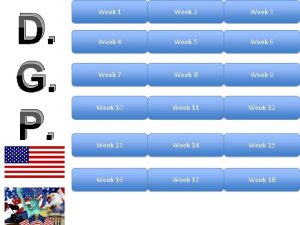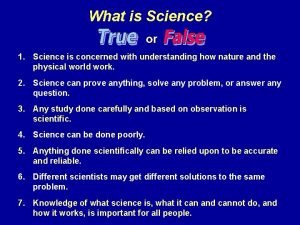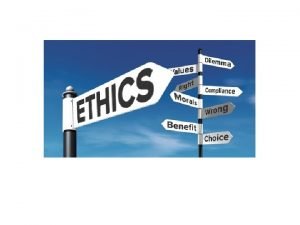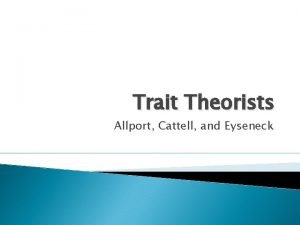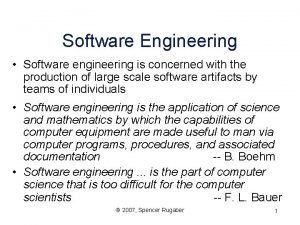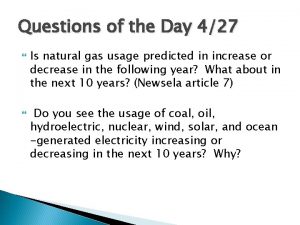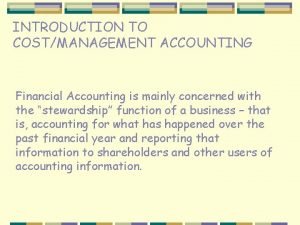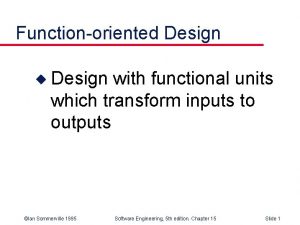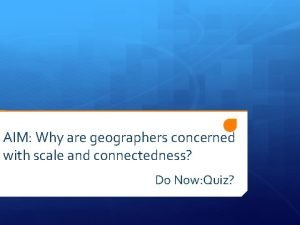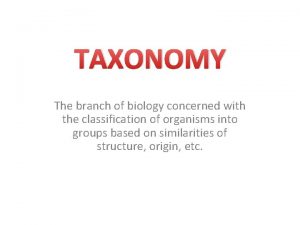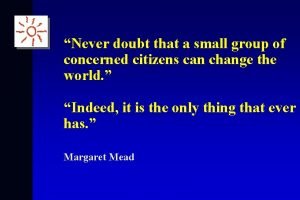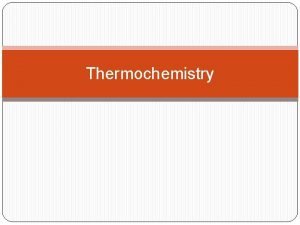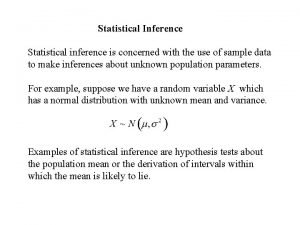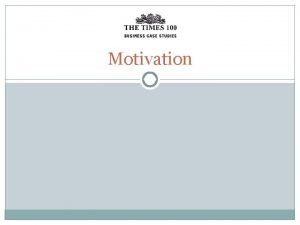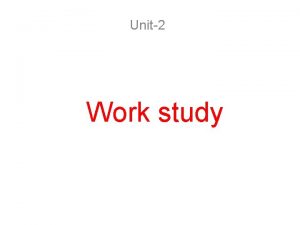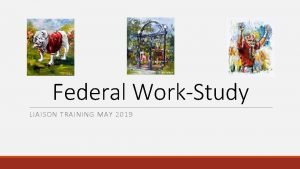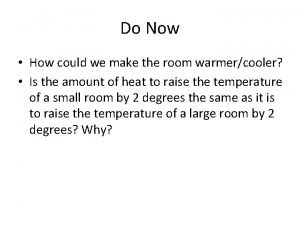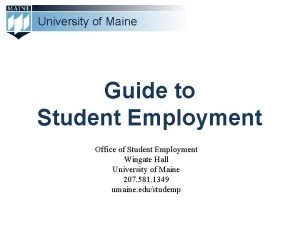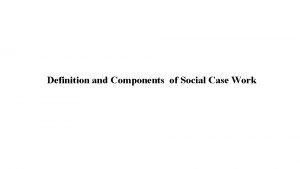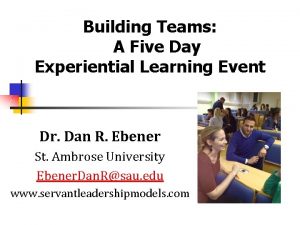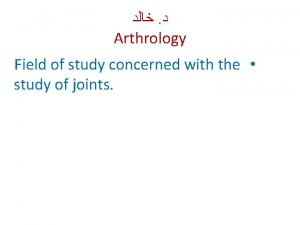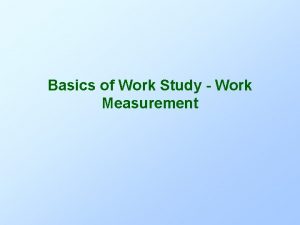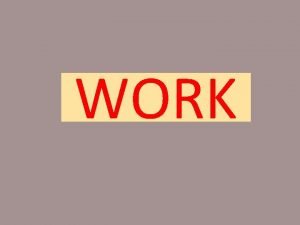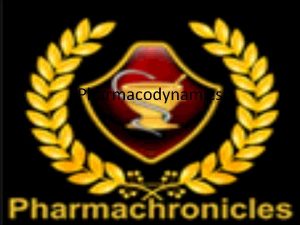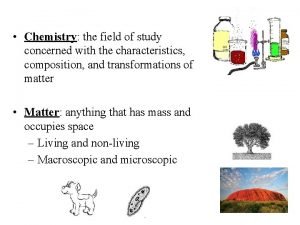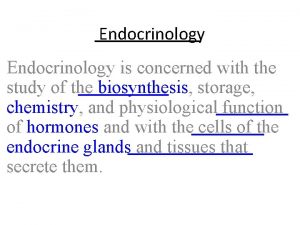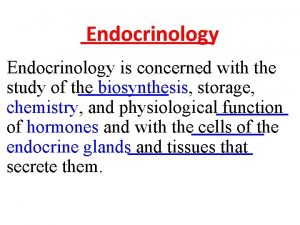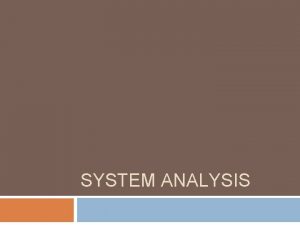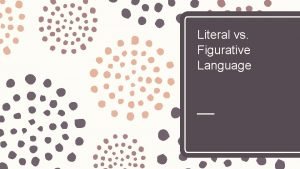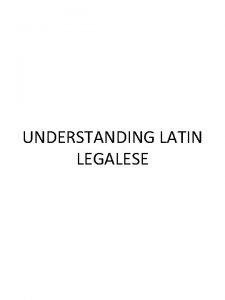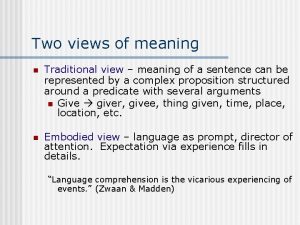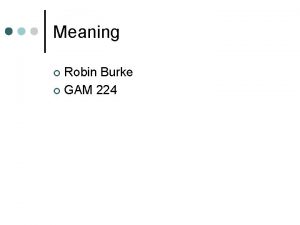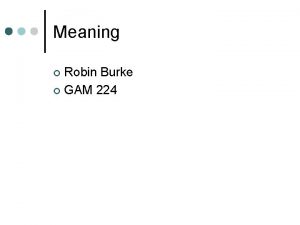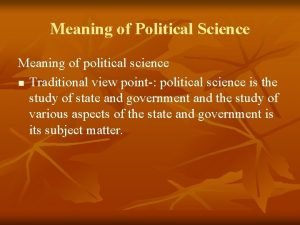MEANING OF WORK STUDY Work study is concerned





















































- Slides: 53


MEANING OF WORK STUDY Work study is concerned with finding better ways of doing work and avoiding waste in all its forms. As such the objective of work study is to assist management to obtain the optimum use of Human, Machine and Material resources available to the organisation for the accomplishment of the work upon which it engaged.

DEFINITION OF WORK STUDY • Definition International Labour Organisation: work study embraces the techniques of method study and work measurement study which are employed to ensure the best possible use of human and material resources in carrying out a specified activity.

ASPECTS OF WORK STUDY 1) Method of performance of a particular work 2) Materials handling 3) Shop floor layout including the layout of the working bench 4) Design and dimensions of the setting as well as the work bench

5)Physical condition governing work performance 6)Maximum and the best possible use of machines and equipments 7)Measurement and timing of work for assessing productivity 8)Checking and improving the motions made in the performance of a job together with the best and least tiring use of hands as well as fuel.

APPLICATIONS/SCOPE OF WORK STUDY The jobs selected for work study are those where the management aspires for having some improvement in efficiency. Work study is undertaken in all those areas: i)Where there is delay in the flow of work. ii)Where an undue or uneven pattern of scrap material or rejection of finished goods has occurred. iii)Where a particular process has been necessitating a reduction in cost, because of various reasons.

iv)Where the output from a particular machine has been failing to reach the expected standards. v)When the management wants to introduce an incentive bonus system vi)When the management is of the opinion that a particular operators time is being wasted leading to a general low efficiency of production.

TECHNIQUES OF WORK STUDY

BASIC WORK STUDY PROCEDURE

PROCESS OF WORK STUDY

NEED OF WORK STUDY 1) The operators who are generally allowed to adopt their own devices might be engaging themselves without proper checks and in most cases, might have not been properly trained either. 2) Even in case the necessary training has been imparted to operators, they might have developed certain bad working habits.

3) Although wrong methods, bad layout and some such other faults have developed in course of time , the foreman might be so preoccupied as to find no time to put a check on them. 4) The top management will not always have sufficient time and the low levels of management may not be having the necessary experience or the training that is required for undertaking work study.

5)Although we always come across one ‘best’ way of performing a task, generally such one ‘best’ way might have been never explored systematically until a systematic work study has been undertaken.

HOW TO ORGANISE WORK STUDY 1) It is advisable to set up a work study committee consisting of the work study officer, the accountant, the works manager and the personnel manager in order to ensure justice in the operation of the work study department. 2) All the members of the works study committee will have to jointly decide on projects and consider all the reports pertaining to the work study.

3) Most of the work study reports will be advisory in character. 4) The head of the departments concerned should be given an opportunity to make his comments on the reports pertaining to his department before they are submitted to the top management.

BENEFITS OF WORK STUDY 1)Increased productivity and operational efficiency 2)Reduced manufacturing cost 3)Improved workplace layout 4)Better manpower planning and capacity planning 5)Fair wages to employees 6)Better working conditions to employees

7)Improved work flow 8)Reduced material handing costs 9)Provides a standard for performance to measure labour efficiency 10) Better industrial relations and employee morale 11) Basis for sound incentive scheme 12) Provides better job satisfaction to employees


PROBLEMS INVOLVED IN WORK STUDY 1)Workers do generally oppose any change that the work study team may suggest 2)It may so happen that even at the top management level, there may be as much resistance to change as on the shop floor. 3)The introduction of work study should never be appear as a fault-finding exercise.

4)Possible fear that may emerge in the minds of the workers that either they will be made redundant or that their jobs will be speeded up, is important. problem. 5)Suspicion on the part of the workers regarding the motives behind work measurement, especially where it involves the use of the stop watch, is yet another problem awaiting a careful solution.

SUGGESTIONS TO MEET THE DIFFICULTIES OF WORK STUDY ü Understand the true nature of work study ü Providing appreciation skills ü Reducing of fear among workers by making necessary statements ü Co-operation by encouraging their participation ü Training of workers ü Management preparedness

REFERENCES 1) S. A Chunawalla D. R Patel (Himalaya Publishing House) 2) K. Aswathappa K. Shidhara Bhat (Himalaya Publishing House) 3) Neeti Gupta & Anuj Gupta( kalyani publishers) 4) Google (Wikipedia)

METHOD STUDY PRESENTED BY –DIVYA SHARMA ROLL NO. 11/16 MCOM-1


METHOD STUDY 1)Method study is a process in which work is critically and systematically examined in order to develop more efficient and easier ways to accomplish the task. 2)Simplification of work or the working methods to achieve higher productivity is the basic motive of method study.

3)It involves systematic recording & scrutinized inspection of existing & proposed ways of doing work for achieving more effective methods & thereby reducing the overall cost

METHOD STUDY PROCEDURE 1) Select the work or job to be studied and defined objectives to be achieved by method study. 2) Record all relevant facts or information pertaining to the existing method using the recording techniques explained on next slide

Process charts: outline process chart Flow process chart Multiple activity chart Motion charts Simultaneous motion charts Layout models & templates String diagram Films and still cameras

Explanation of procedure of method study 1)Process and Flow Diagrams: It indicate the progress of materials & components through the production process. The various symbols are used for recording on the chart are given below:

Explanation of procedure of method study ACTIVITY SYMBOL PURPOSE Operation It Indicates the main steps in a process or method. Inspection The square denotes inspection involving verification of quantity/quality. Transport The symbol refers to the movement of workers, material or equipment from one place to another. Storage The reverse triangle denotes storage in one place and restricting unauthorised removal. Delay D It represents a delay in the sequence of events. It is also used to denote temporary storage.

FLOW PROCESS DIAGRAM D Details regarding method OPERATION TRANSPORTATIO N INSPECTION DELAY STORAGE 1. Raw mat. In store 2. Design 3. Inspection 4. Sent to Sewing 5. Delay in Sewing 6. Sewing 7. Inspection 8. Packing 9. Despatch D

2)Multiple Activity Chart : The chart is used to record the time relationships between two or more workers, machines or materials. The multiple activity chart thus, records the sequence of activities of more than one subject(men, mat. or equipment) on a common time scale. All the activities are recorded in a sequence in terms of working time & idle time. OPERATION DELAY INSPECTION TRANPORTATION STORAGE

(I)OPERATION When an object is intentionally changed is one or more of its physical or chemical characteristics operation occurs. An operation always takes the object one stage ahead towards completion. some examples of operation are: # Turning, Drilling etc # A Chemical reaction # Welding # Getting instructions from supervisors

(II)DELAY When the immediate performance of the next planned thing/process does not take place, a delay occurs. some examples of deal are: # Workers waiting at tool cribs # Operators waiting for instruction from supervisors

(III)INSPECTION When an object is critically examined and compared with the standard for quality and quantity, an inspection occurs. some examples of inspection are : # Visual observation for finish # Count of quantity of incoming material # Checking the dimensions

(IV)TRANPORTATION When there is a movement of workers, materials or equipment from one place to another, it is termed as transportation some examples of transportation are: # Movement of material from one work station to another. # Workers travelling to bring tools

(V)STORAGE Indicates a controlled storage in which a material is issued or received from the store under some form of authorization, or an item is retained for reference purposes. some examples of storage are : # Raw material in bulk storage # Protective filing of documents

3)MOTION CHARTS These indicate the movements of an operative. They allow for analysis and , wherever, possible, the elimination of unnecessary movement or the design of more economic movement.

4)SIMULTANEOUS MOTION CHARTS(SIMO) It helps to record simultaneous movements of the hands. In this chart the movement of 2 or more body parts of the workers is recorded. The various symbols used on such charts are called therbligs.

5)LAYOUT MODELS TEMPLATES A templates also called template layout. It is nothing but a drawing of particular machine cut out from a sheet of a heavy paper, plywood, board etc. The various templates representing machines, tools, tanks etc. are laid on the floor plan to give a clear cut picture of the layout plan.

6)STRING DIAGRAMS Wherein work positions are marked with pins and connecting lengths of string indicate the path an operative takes during the course of his work and the total distance travelled during a period. It allows for the thinking and development of a more economic movement plan.

7)FILMS AND STILL CAMERAS For recording some specific types of operations; A) Analysis of the record and quantification. Eg. Elimination of an operation, combination of one or more operations. B)Examination of the methods including the job, the work place, the tools, etc. and seeking alternatives C)Developing a new method of performing the work with the necessary details being suitably charted; mathematical comparisons with the old method may also be produced.

C)Developing a new method of performing the work with the necessary details being suitably charted; mathematical comparisons with the old method may also be produced. D)Installing new methods on the requisite authority by the management and providing instruction for its use. E)Maintaining the new methods to ensure that they are working satisfactorily.

OBJECTIVES OF METHOD STUDY 1)Improve not only the individual process; but also the inter-relationships of various other processes involved 2)Suggest more efficient use of manpower, machines and materials 3)Improving the factory & the work place layout

4)Achieve economy in human effort and reduce the fatigue 5)Introduce better working conditions, wherever possible 6)Improving the use of materials, plant & equipment & manpower 7)Reducing the monotony of work

8)Work simplification 9)Improved working methods 10)Better quality product 11)Better working conditions 12)Optimum utilization of all resources 13)Reduce material consumption and material 14)Reduce manufacturing cost & higher productivity

MOTION STUDY

MOTION STUDY Motion study is concerned with increasing the efficiency of human movements only. As motion study is part of method study. Key Ideas which Guide Research on Work Improvement: (1)Every person engaged in the performance of work should, to the extent possible, employ both hands simultaneously. (2)He should not idle both hand at the same time (3)He should ensure that motions of arms are simultaneous in opposite or symmetrical direction. (4)Care should be taken to insist upon the definite locations for materials, work in progress, machines and tool in such a way as to permit the best sequence of motions especially in planning the work place.

(5)One should prefer-(i) arm movement to shoulder movements (ii) arm and wrist movement to arm movements alone. (6)Continuous curved motions require less effort. (7)The hands are to be assisted by the other parts of the body whenever possible. (8)The term generally understood from its musical usage, is generally used in motion study as it is essential to a smooth automatic performance. (9)The concept of momentum can be of assistance once an item is in motion.

OBJECTIVE OF MOTION STUDY v. To study the existing method v. To developed an improved method v. To reduce Excessive material handling v. To improve utilization of resources v. To eliminate wasteful and inefficient motions

MACHINE DESIGN AND WORK IMPROVEMENT v Best position for the work v Primitive yoke method should be used v Equipment is so designed as to allow the operator to either sit or stand alternatively, to reduce fatigue and increase productivity v Designing of the equipments should be adjustable v Care must be taken to ensure the controls and dials are as simple and realistic as possible

REFERENCES 1) Neeti Gupta & Anuj Gupta( kalyani publishers) 2) Google (Wikipedia) 3) Antara Shantilal, Rajat Ganesh Jadhav, Amey Babar (Jawaharlal Nehru College of Eng. , Cidco, Aurangabad Maharashtra, INDIA)

 Branch of biology concerned with the study of fungi
Branch of biology concerned with the study of fungi Thermochemistry is the study of
Thermochemistry is the study of Thermochemistry is the study of
Thermochemistry is the study of Method study in management
Method study in management The network layer concerns with
The network layer concerns with Concerned with quantity
Concerned with quantity Biology is concerned with
Biology is concerned with Formal vs functional region
Formal vs functional region Cuss graded assertiveness
Cuss graded assertiveness The social science concerned with how individuals
The social science concerned with how individuals I wish that i were old enough to vote dgp
I wish that i were old enough to vote dgp Pluralist democracy
Pluralist democracy What is science concerned with?
What is science concerned with? Science is concerned with
Science is concerned with Is ethics a branch of philosophy
Is ethics a branch of philosophy Allport personality theory
Allport personality theory Software engineering is concerned with
Software engineering is concerned with Union of concerned scientists
Union of concerned scientists Bookkeeping is mainly concerned with
Bookkeeping is mainly concerned with In structural decomposition are concerned
In structural decomposition are concerned Why are geographers concerned with scale and connectedness?
Why are geographers concerned with scale and connectedness? Biology is concerned with
Biology is concerned with Never doubt a small group of concerned citizens
Never doubt a small group of concerned citizens Cipher based message authentication code
Cipher based message authentication code Biology is concerned with
Biology is concerned with Biology is concerned with
Biology is concerned with As far as i m concerned
As far as i m concerned Thermochemistry is concerned with the
Thermochemistry is concerned with the Statistical inference is concerned with
Statistical inference is concerned with Social motivaiton
Social motivaiton Thermodynamics is concerned with
Thermodynamics is concerned with What is case series
What is case series Retrospective cohort study vs prospective cohort study
Retrospective cohort study vs prospective cohort study Study less study smart
Study less study smart Phytogeography of india
Phytogeography of india Distinguish between time study and motion study
Distinguish between time study and motion study Distinguish between time study and motion study
Distinguish between time study and motion study Definition of work study
Definition of work study Work study examines *
Work study examines * Chapter 5 how ecosystems work study guide
Chapter 5 how ecosystems work study guide Nvcc work study
Nvcc work study Federal work study uga
Federal work study uga Method of heat transfer
Method of heat transfer Wingate hall umaine
Wingate hall umaine Activity 4 conflict resolution work immersion
Activity 4 conflict resolution work immersion Training plan outline for work immersion sample
Training plan outline for work immersion sample Smart work and hard work
Smart work and hard work Present continuous work
Present continuous work Model of social group work
Model of social group work What is a casework
What is a casework Team vs working group
Team vs working group Physics 03-01 work and the work-energy theorem
Physics 03-01 work and the work-energy theorem Chapter 4 section 1 work and machines answer key
Chapter 4 section 1 work and machines answer key I work all night i work all day to pay the bills
I work all night i work all day to pay the bills
